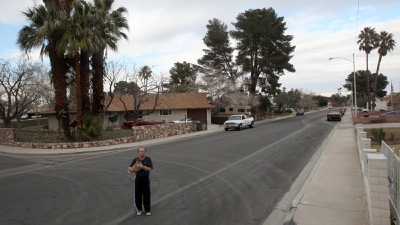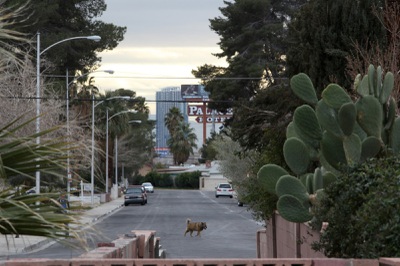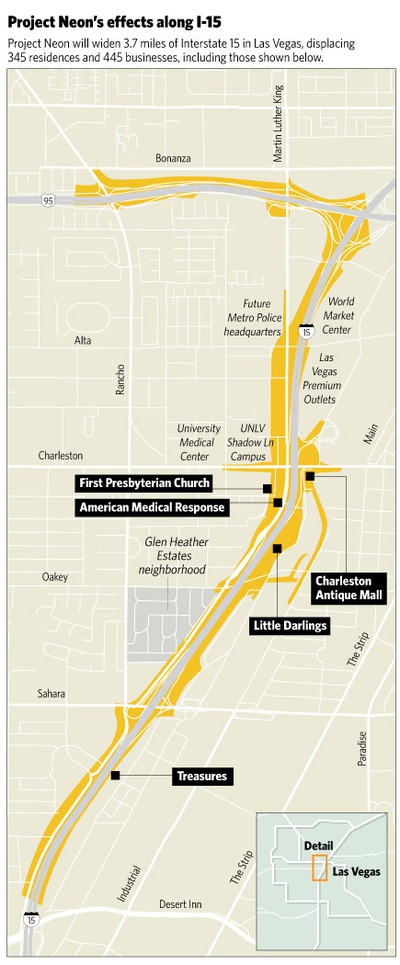
Chris Morris / Special to the Sun
Sunday, March 7, 2010 | 2 a.m.
Sun Coverage
Beyond the Sun
Glen Heather Estates homeowners are bracing for more than 10 percent of their neighborhood to be wiped out. Twenty-three homes are expected to be bulldozed and covered with pavement as part of the widening of Interstate 15 from Sahara Avenue to the Spaghetti Bowl.
But Glen Heather is not the only neighborhood that will shrink as the freeway gets bigger. Even though Project Neon, as the Nevada Transportation Department has dubbed it, will change only 3.7 miles of I-15, it is expected to gobble up 345 residences and 445 commercial properties on 93 acres.
The home Ray and Nina McKinley have lived in since April 1994 is on that list. Knowing the day is coming when they will be forced to sell and move is nerve-racking enough. Not having a better idea of when that day will arrive makes it worse, says Ray McKinley, a retired union electrician.
It’s a common complaint among people who are in the freeway’s path.
The timing is crucial for numerous reasons, especially because it will affect how much money the state pays the homeowners as property values can vary wildly over a few years.
But after years of planning and public meetings, the massive funding needed for the project looks like it has been delayed because of the Great Recession and Congress’ failure to pass a transportation bill. The price tag is $1.8 billion, and the work is expected to take about 20 years.
State officials hope to begin work as early as next year, and the properties likely to be affected first would be businesses — everything from the Little Darlings and Treasures strip clubs to the Charleston Antique Mall and American Medical Response ambulance company. Some will only be partially affected.
Alson Lee, Treasures’ general manager, says the worst-case scenario for his business is the state will tear down a quarter of his building. He’s secure in the knowledge that the state is going have to cut Treasures a fat check.
“It’s going to be expensive,” he says.
He’s skeptical that the state will get the project started anytime soon. Until he gets better answers on what will happen and when, he isn’t worrying too much.
“It has taken forever already,” he says. “We’ll stay on top of it, but we don’t really see that it’s going to happen in the very near future.”
“Not getting an answer on the time frame” is the main concern of the Glen Heather Estates Neighborhood Association, says Shelly Walters, its president.
State officials say they can’t provide precise answers because the state doesn’t have those answers yet, especially for the owners of 48 houses in construction’s path, because those properties could wind up being the last purchased.
Most of the residences are apartment units west of the freeway and north of Charleston Boulevard. Most will go in the second phase of the project. The homes are part of the third phase.
McKinley is hoping for sooner rather than later. “I’d like to stay, but since I know it’s going to come I want to just get out and look for something else,” he said.
His neighbor Greg Clemensen says, “The longer it takes the better. It’s probably inevitable that we’re going to have to move at some point, but we don’t really want to. My concern is that the government will not give a fair price for the home. What’s fair to them might not be fair to me.”
When it does come time to discuss price with the state, he’ll be dealing with Carol Lamb, the Transportation Department’s supervisor for right-of-way acquisition in Southern Nevada. Her office is in the middle of the department’s Las Vegas maintenance yard, a few miles up I-15 from Glen Heather Estates.
Property owners almost always are apprehensive about the state taking their land, homes and businesses, she says. “It is a very intimidating process. It should not be scary, but it is traumatic, and we understand that.
“You have families who have lived in their houses for years. They raised their kids there, they expected to retire there, and here we come and disrupt their lives,” she says. “But they move into, a lot of time, nicer properties or properties that more accommodate their current needs and then they build new memories. So in most cases it turns out to be a betterment for them.”
By federal law, the state is required to pay owners the fair-market value of the property and move them to a comparable property. Once the project begins, an assessor determines the value of each property. The department then negotiates with the property owners on a price above the assessed value.
The state must pay the property owner for the cost of the move. Other expenses are covered, such as reimbursements for tenants. Some renters who have been displaced have used their compensation as down payments on their own homes, Lamb says.
“I’ve been doing this for 15 years. To date I have not had one person that a year after it’s done has not been happy with the way it turned out,” Lamb says. “Most people, when they understand the process, even though they may not like (moving), they find the added benefits are good for them. And it gives them an opportunity to upgrade their living conditions to a bigger house, a smaller house, a bigger yard, a smaller yard — whatever fits their lifestyle.”
Clemensen attended meetings on the acquisition process and he says: “Supposedly you’re not going to get rich from it, but you’re not going to end up poor either.”
The problem is you’re definitely left twisting in the wind until the state buys your property, Clemensen’s neighbor Gina Holly says. She and her neighbors complain they can’t plan their futures and don’t want to spend money on improving their homes.
Lamb says once the project officially begins, a right-of-way agent will be assigned to each homeowner to help and answer questions. She comes armed with handouts from the state and federal governments to explain everything, she says.
But that can’t happen until after the design studies, and the federal government gives its OK and the money is in place.
“We would start it tomorrow if we could,” Lamb says.
Dan McMartin, Project Neon’s deputy manager, says he and other Transportation Department officials are aware of how anxious some of the property owners are.
“It’s actually cooking right along, though,” he says. “I know everyone doesn’t think that, but this is the normal process on a project of this size.”





Join the Discussion:
Check this out for a full explanation of our conversion to the LiveFyre commenting system and instructions on how to sign up for an account.
Full comments policy